email marketing para windows 8
Hubspot User Group Meeting Meeting September 2018 - London HUG
This is a transcript of the talk given by Pete Nichols ,from HubDo, at the HubSpot User Group Meeting in September 2018, in London.
Youtobe
email marketing para windows 8
This is a transcript of the talk given by Pete Nichols ,from HubDo, at the HubSpot User Group Meeting in September 2018, in London.
Youtobe

As a child, I did everything that most kids did. I played outside with friends, I watched a lot of TV, I loved eating cereal for breakfast, and I went to school.
My childhood wasn’t too much different than yours. But there was one thing that was a bit unique.
I grew up watching Bloomberg before I went to school.
Now, I don’t want you to think I was some child prodigy because I wasn’t. The only reason I watched Bloomberg in the morning is that my dad dabbled in the stock market and wanted to know if his stocks were going up or down.
Plus, we only had one TV… so I didn’t really have a choice.
But from all of those years of watching Bloomberg, it wasn’t too hard for me to spot trends. And one of the big ones is globalization.
See, as a kid, most of the financial news channels discussed how things were progressing in America.
But now, due to technological advances, companies no longer see themselves as regional or even national. Things like headquarters no longer matter.
Companies look at themselves from a global perspective. And every big company out there has done well because they focus on attracting customers from all over the world as it’s a much bigger pool and opens up more potential revenue.
And it’s not just businesses, it’s people too. When children go to school these days, their parents think about how they are going to stack up against kids in other countries versus kids just from their own classroom.
So, with everyone thinking from a global perspective, why do you think of your SEO from a national or regional perspective?
Don’t beat yourself up just yet, I used to think about SEO from a national perspective until a Google employee opened up my eyes.
And once I cracked the nut of international SEO, my traffic exploded…
Here’s how many visitors NeilPatel.com received over the last 7 days.
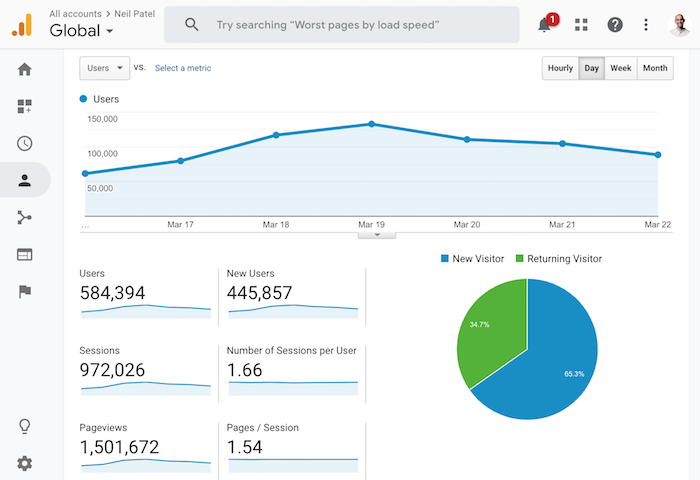
In the last 7 days, there were 972,026 sessions on my site that generated 1,501,672 pageviews. And of those visitors, 584,294 where unique people. Hopefully, you were one of those unique people. 😉
But this is where it gets interesting…

The United States only makes up 22.35% of my traffic.
The rest is coming from other countries and, in many of them, English isn’t their primary language. Just look at the chart above… Brazil, India, Germany, Spain, and France are all examples where I am generated a lot of traffic from.
Of course, there are people all around the world that speak English, but the big reason for the growth is that I started to expand internationally by doing things like translating my content.
Just click on the language selector next to my logo and you’ll see some of the regions I am going after.
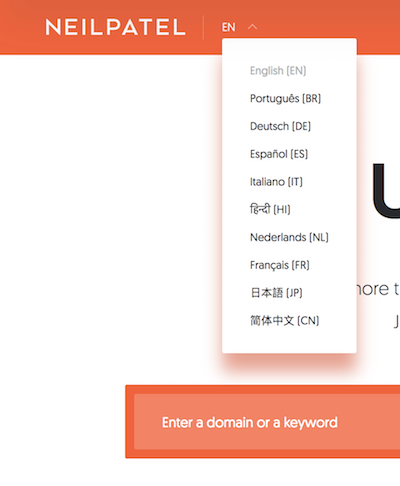
The simple answer is to translate your content. If you translate your content into different languages, in theory, you should get more traffic.
Just look at the most popular languages all across the globe:
But what most people won’t tell you (because they haven’t done it enough times) is that translating your content isn’t enough. Even if you translate it and adapt it to a specific country, it doesn’t guarantee success.
I had to learn this the hard way.
Case in point, here are the traffic stats during the last 7 days for the Portuguese version of my blog:

And here are my traffic stats during the last 7 days for Spanish:
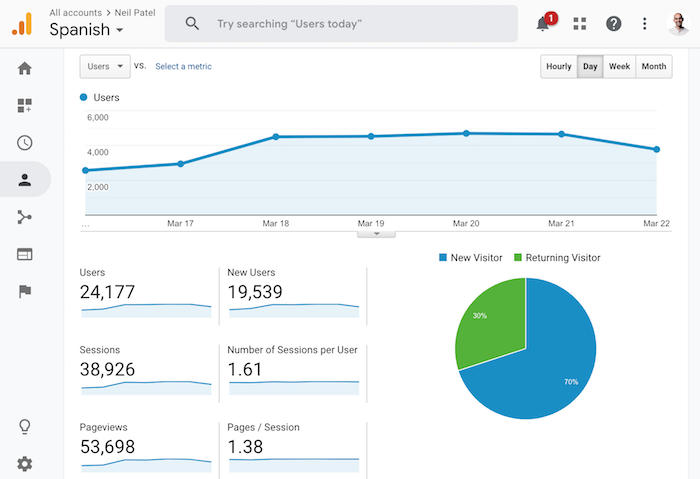
I get a whopping 238% more traffic on the Portuguese version of NeilPatel.com than I do on the Spanish version.
Here’s what’s interesting…
Here’s the backlink profile to the Spanish version:
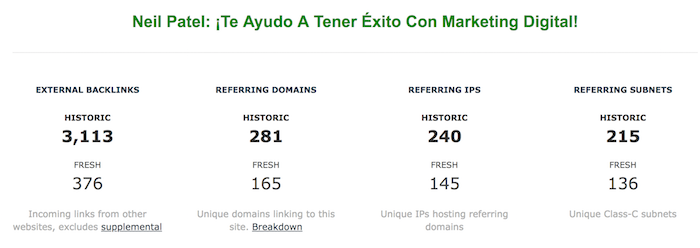
And here is the backlink profile of the Portuguese version:
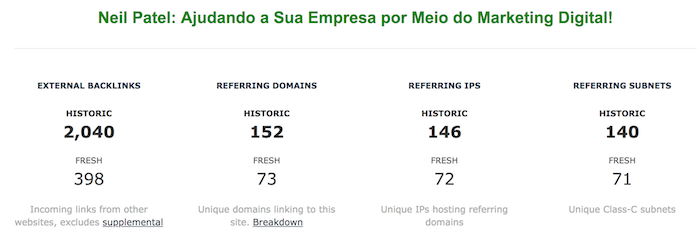
As you can see, the Spanish version has 52% more backlinks.
Are you puzzled why the Spanish version of my blog isn’t as popular? There is a reason and I’ll give you a hint. Here’s a quote from Eric Schmidt who used to be the CEO of Google:
Brands are the solution, not the problem. Brands are how you sort out the cesspool.
Need another hint?
Here’s how many people land on my site from branded queries (people searching for my domain name or variations of it) in Spanish speaking countries:
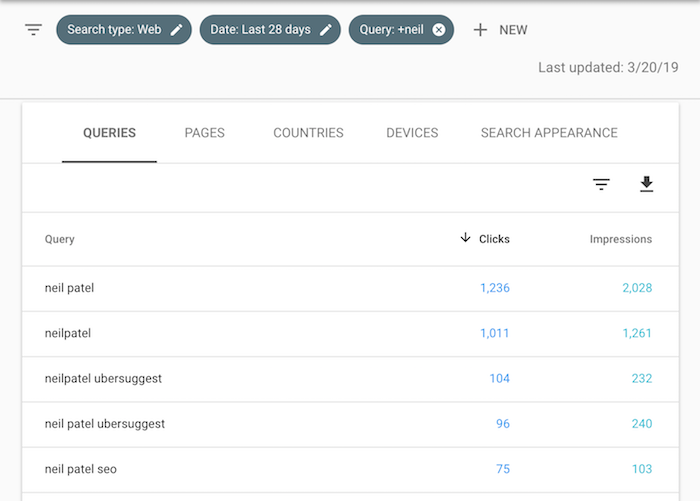
And here’s how many people land on my site from brand queries in Portuguese speaking countries:
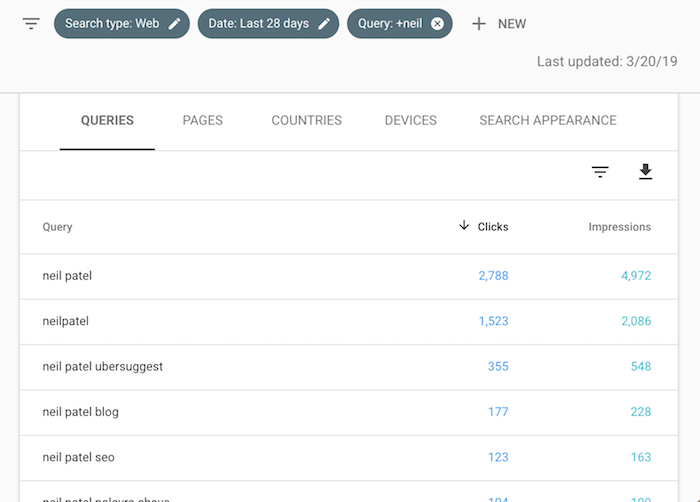
That’s why I get so much more traffic from Portuguese speaking regions like Brazil. I have 104% more brand queries.
It’s something Google values so much that most people ignore.
And it’s not just me. I have analytics access to 18 other companies that have a global strategy due to my ad agency. I obviously can’t share their stats, but it just shows the power of brand queries from a global perspective.
Based on my site and helping 18 other sites go global, I’ve learned what works and what doesn’t. Sadly, I made one too many mistakes, but you won’t as long as you follow the advice below.
You have to translate and adjust your content to each region you want to target. You can do so by hiring translators on sites like Upwork, but the quality may be low.
Now, this doesn’t mean Upwork is bad, more so you should consider getting an editor who knows the local market, speaks the local language and speaks English, and understands the niche you are working in.
This way they’ll understand your goals, your original content, and the market you are going after.
And similar to finding translators on Upwork, you can also find editors there too. Just interview a few and ideally look for people with experience in your field.
The last thing you want to do is translate 100 articles to find out that they were all low quality and you have to do it all over again.
Popular keywords in one language aren’t always popular in other languages.
Read this article to get an overview of how I rank for 477,000 keywords. It teaches you the concept of key expansion and it’s important for your translators and editors to understand the process. You’ll want them to use it.
In addition to that, have them use free keyword research tools like Ubersuggest as it will give them more ideas. I would also have them check out this tutorial as it will teach them how to get the most out of Ubersuggest.
By understanding which keywords to go after in new markets, you can start creating new content (beyond just translating) to target keywords that are relevant and have high search volume. By understanding where there are gaps in the quality of the competition’s posts, you’ll be able to produce new, high-quality content that can rank quickly.
The article on my Portuguese blog, for example, that gets the most organic traffic from Google is an article that only exists in Brazil. We found a keyword to go after that had low competition but high search volume and were able to rank very quickly for it. In the last 30 days, that article has had 17,197 visits.
Building links in English may be hard, but internationally it’s easy.
No one really sends those cold outreach emails begging for links, so when you do this for countries like Brazil, you’ll find that it is fishing with dynamite.
Again, you’ll want someone who knows the language to do the outreach… this can be your editor or someone you hire from Upwork.
Once you have the person who is going to be in charge of your link building, have them start with this. It will break down what they need to do step-by-step.
Make sure you let them know to avoid spam sites, paying for links, and even building rich anchor text links.
Remember in these markets SEO isn’t as competitive, so it won’t be too hard to get rankings.
Google doesn’t penalize for duplicate content… especially when it is in a different language.
If you translate your content, it isn’t as simple as popping it up on landing pages. You have to tell Google which version to show for each country/language. You would use hreflang for that.
Here’s a video that explains how it works:
And here is a tool that’ll help you generate the hreflang code needed for your site.
On NeilPatel.com, you’ll notice that I use subdirectories for each language/country over subdomains.
They say subdirectories are better because more authority and juice flows through your site versus using subdomains.
But here’s what I learned the hard way, you are much better off using subdomains from everything that I tested than subdirectories.
Not only is it easier to rank as it is treated as a separate site, but it ranks faster from my experience. And if you don’t mind spending the extra money, I would even consider registering the international variation of each domain and forwarding it to the respective subdomain.
Similar to how Google Analytics shows you the browsers people are using and countries and languages people come to your site from… your server is also getting that data.
What you’ll want to do is redirect users once you’ve translated your content and set up your hreflang tags.
For example, if you were to visit this site form Brazil and your browser told us that your preferred language is Portuguese, we would automatically forward you to the Portuguese version of the site. Not just to the homepage, but to the correct page you were originally browsing, just the translated version.
Now if you were visiting this blog from India and your browser stated that your preferred language was English, we wouldn’t forward you to the Hindi version of the blog. We would keep you on the English version as that’s what you prefer.
If you don’t forward people, you’ll find that it takes search engines much longer to realize that they should be ranking the language and country-specific sections of your site instead of the English version.
As I mentioned above, international SEO isn’t just about backlinks or content, it’s about building a brand.
I pay in each country to respond to my blog comments as I don’t speak Spanish and Portuguese so I can’t personally respond to them.
I show them how I respond to comments in English so they can replicate me.
I also spend money on boosting posts on Facebook within those regions as it helps me attract new potential readers and get my brand out there.
And most importantly, I hire people on the ground in each country to help build up my brand. That’s why I do so well in places like Brazil over the Spanish market.
I have more people on the ground in Brazil focusing on brand building. From attending conferences to representing my brand on webinars… they put in the effort to truly help people out when it comes to anything marketing related.
That’s how you build a brand. Just look at my Instagram channel, the content is in English, but a lot of my followers are from Brazil due to the localized brand building efforts.
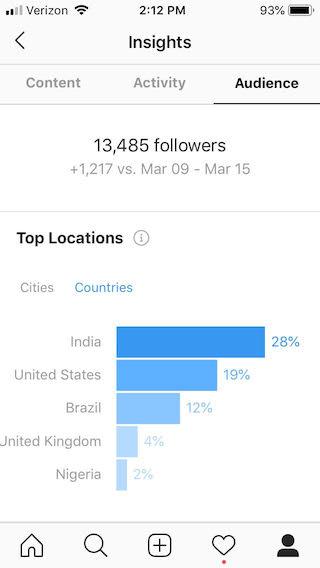
Do you remember Accelerated Mobile Pages (AMP)? No one talks about AMP anymore, but it does help increase traffic.
What we’ve found through testing is that in regions like the United States, AMP doesn’t do much, if anything, for your traffic.
But for regions like Brazil and India, where their infrastructure is still developing, we found that leveraging AMP boosts mobile search traffic by anywhere from 9 to 32%.
If you don’t want to use AMP that’s fine too. Just make sure you optimize your load speed times. Not only does it boost traffic, but it also boosts conversions.
Similar to how it takes forever for you to get Google rankings in English speaking markets, it does take time internationally. Typically, not as long as it does for the United States or United Kingdom markets, but it does take time.
Typically, if you are doing everything above, you’ll see some results within 3 months. Things will really take off at the 9-month mark and after a year you should be crushing it.
Now as your traffic and rankings go up, this doesn’t mean you should slow down. Just like how you can lose rankings on your English site, the same can easily happen for any other region.
You got everything done when it comes to international SEO… all that’s left is tackling the right regions.
It would be great to go after every language and country at once, but it’s going to be too resource intensive and costly.
You could try tactics like automatically translating your content through machine learning, but the translations won’t be great and your user metrics such as bounce rates will go through the roof. This typically will lead your whole site’s rankings to tank.
You don’t want to do that.
Another approach people take is to go after the markets with the highest GDP… such as the USA, China, Japan, UK, Germany, etc…
But going after markets that have money doesn’t guarantee success either because culturally each region is different. Some may not care for your products or services.
What I like doing is to look at your Google Analytics and see where your traffic is coming from. Are you getting traffic from countries where English isn’t their main language? And, if so, are people from those countries buying your products and services?
If they are, now you have a list of potential countries to go after.
Then what you’ll want to do is look at your competition and see if they are going after any regions by translating their sites. Chances are if a region that isn’t predominantly English speaking is driving you sales, and your competitor is translating their content for that region, then you should be going after it as well.
SEO is no longer about ranking your site in one country or even just English-speaking countries.
You have no choice but to think of it from a global perspective. Not only is it more affordable, but there is less competition and you can see results faster.
Sure, the total market of some of these international countries may only be a fraction of the United States, but there won’t be much competition, which means you can gobble up the market share.
So what countries are you focused on with your SEO?
email marketing developer cover letter
This article is a summary of the presentation talk by Juliana Nicholson from HubSpot at the HubSpot User Group Meeting in June 2018. The full transcript of the talk and the video presentation can be seen by following this link.
6 email marketing software reviews

I started content marketing in the early days. So early that when I first met the WordPress founder, he had just raised $1.1 million for WordPress.
Fast forward to today and WordPress is worth over a billion dollars.
Similarly, when I first started with content marketing, there were less than 30 million blogs that existed and now there are over a billion.
In other words, things have changed drastically and now it’s what more competitive.
We are at a point where you already know you need to leverage content marketing. But what areas of content marketing should you focus on?
How many blog posts do you need to write? What are the best ways to monetize your traffic?
How can you ensure that what you are doing will work in the future?
To shed some light on where content marketing is headed, I’ve gathered data from 183 companies who are all leveraging content marketing. Each company makes at least 5 million dollars in revenue a year and generates less than $1.9 billion a year.
These companies are in all different sectors, from B2B to B2C, and are part of all the major industries out there. Most importantly, they have been leveraging content marketing for at least 8 years.
Now, I know many of you don’t have a company that generates at least 5 million dollars a year, but the stats and data I will show you are still relevant to your blog.
So, let’s dive into the stats to see where content marketing is headed.
What do you think has happened to social shares over time?
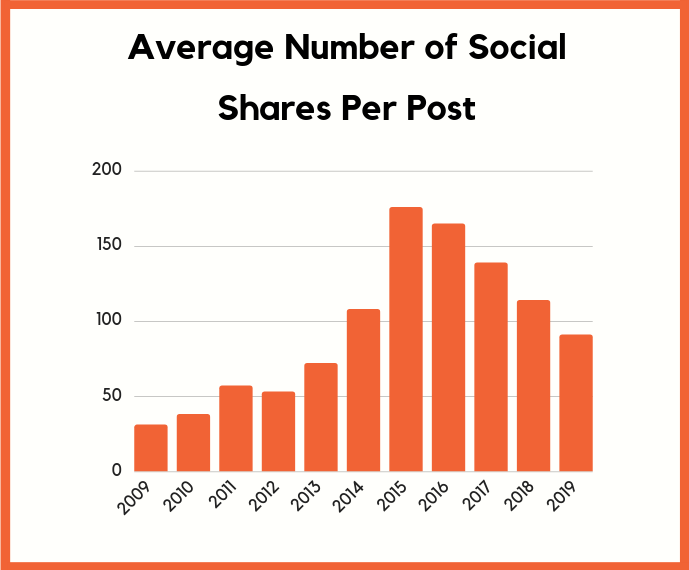
As you probably guessed, social shares have gone down because the algorithms (like on Facebook) really limit organic reach.
In the early days, people saw big lifts in their social share count due to the fact that these social sites were still growing in popularity. But once their growth slowed down, so did the number of times the shares each piece of content generated.
If you are wondering why just think of it this way… when people share content on social sites it drives users off of the platform. By keeping people on Facebook longer (or any other social platform), they make more money as people click on ads.
If you are expecting to grow your blog through the social web, think again. It’s slowly driving less and less traffic each year and you should expect it to get worse.
Can you guess what’s the most popular traffic channel for a blog?
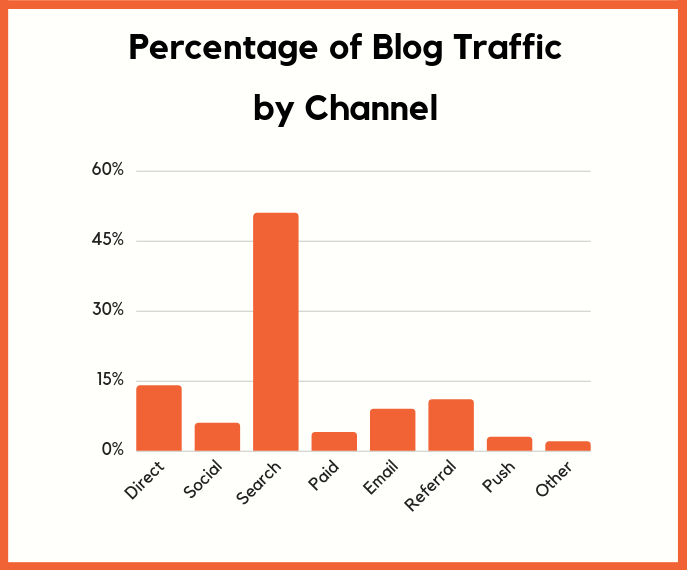
SEO made up 51% of the blog’s traffic and to no surprise, social media was the 5th most popular channel.
But what was surprising is that referral traffic was in 3rd place at 11% and email was at 9%.
Instead of just focusing on link building to boost your rankings, you should focus on link building to also increase your referral traffic. In essence, you can get more bang for your buck by increasing two different ways to drive traffic with one strategy.
Whether it is guest posting or generating PR, you should try and get as much referral traffic as possible as it creates steady traffic that isn’t too affected by algorithm updates.
As for email, you may think it’s dead, but it’s alive and kicking strong. Remember, everyone who works in the corporate world still uses email.
Don’t be shy about collecting emails. You can use tools like Hello Bar to do this with ease.
Now going back to SEO for a moment… here’s why you have to blog.
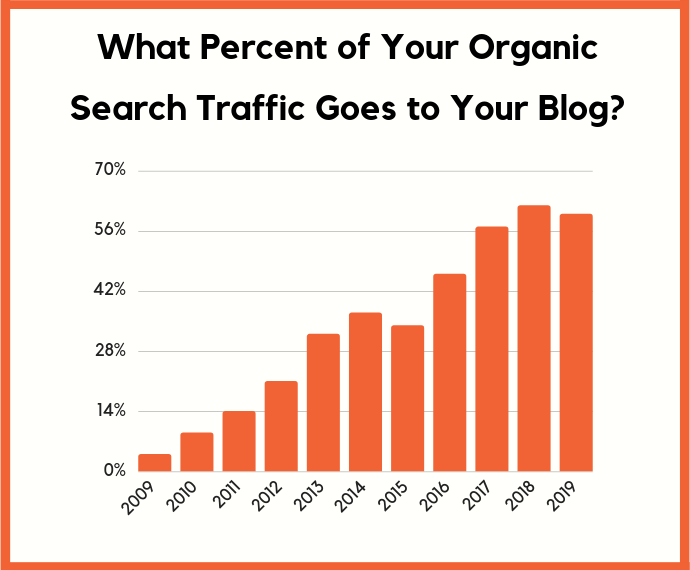
As you can see from the graph above, Google has continually shifted from ranking web pages to pushing up content over time. And it doesn’t look like that the trend is stopping anytime soon.
Blogs are generating, on average, 60 to 62 percent of a site’s search traffic. Sure, it’s going to be different for the Amazon’s of the world, but you aren’t them… and neither am I.
SEO is also getting more competitive because there are more blogs popping up and people are creating tons of content. But you have no choice but to do the same if you want to keep up.
Well, just look at it this way…
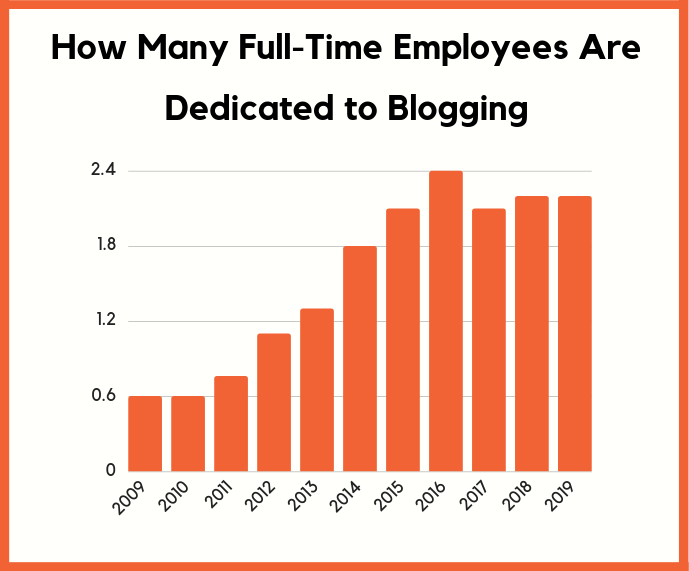
On average, mid-sized companies now have at least 2 full-time employees managing their blog. It’s because they know content marketing isn’t going anywhere without putting in real effort and you need to take it seriously if you want to grow fast.
And on top of having dedicated employees, the average mid-sized company has a bit more than 10 contractors working on their blog.

Now, I don’t want you to get scared by that number as a lot of those contractors are writing content. They are not working full time… it’s as simple as some of them writing only a handful of content pieces a month.
Or it could be as simple as them helping you produce video content or create infographics.
With your blog, you should consider hiring more contractors as writers instead of hiring full-time employees as it is cheaper.
It’s also more efficient to have contractors as you can scale up and down faster. On top of that, you’ll find that you will save money in the long run as contractors and consultant tends to be cheaper than full-time employees.
Out of the 183 blogs we talked to, they publish 22.8 pieces of content per month on average.
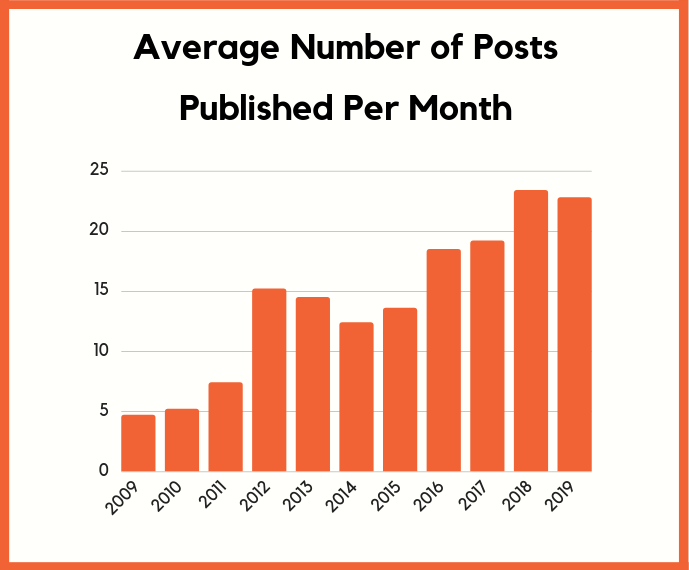
And can you guess how long each of them is?
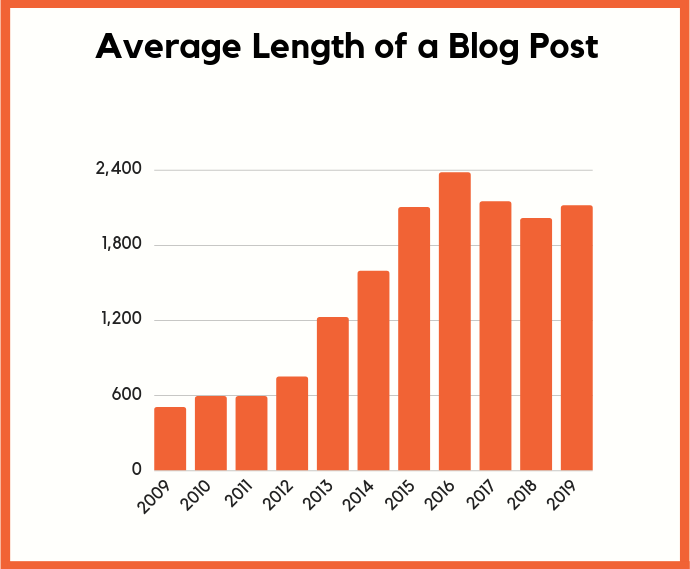
Well, they say that if you want to rank on page 1, you need to write content that is 1,890 words.
Most of the blogs we analyzed and talked to all followed one common theme… as time went on, they started writing longer posts.
They are now averaging 2,118 words per post. In 2016 that number peaked out at 2,381 words because people started producing in-depth guides, which caused that number to spike.
But what they found over time is that writing content that is too in-depth, such as guides, doesn’t necessarily guarantee higher rankings.
To give you an idea, years ago I wrote a 30,000-word guide on SEO. Can you guess what page it ranks on for the term SEO?
It ranks on page 2.
Now, this guide to SEO is much shorter and ranks on page 1.
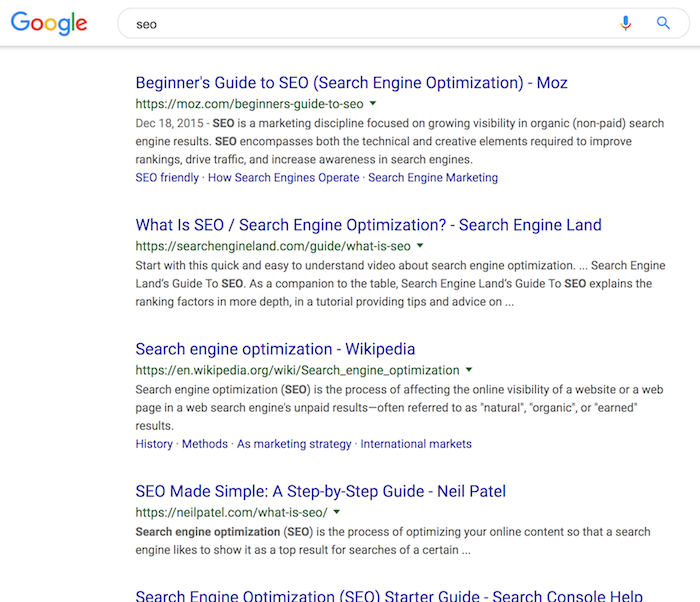
In other words, it is better for you to create more content than it is to create one super long blog post.
Think of your content as fishing hooks. If you have more fishing hooks out, there is a greater chance of catching a fish.
The same goes with blogging, the more content you create (assuming it is high quality), the higher the chance you’ll have of attracting more visitors.
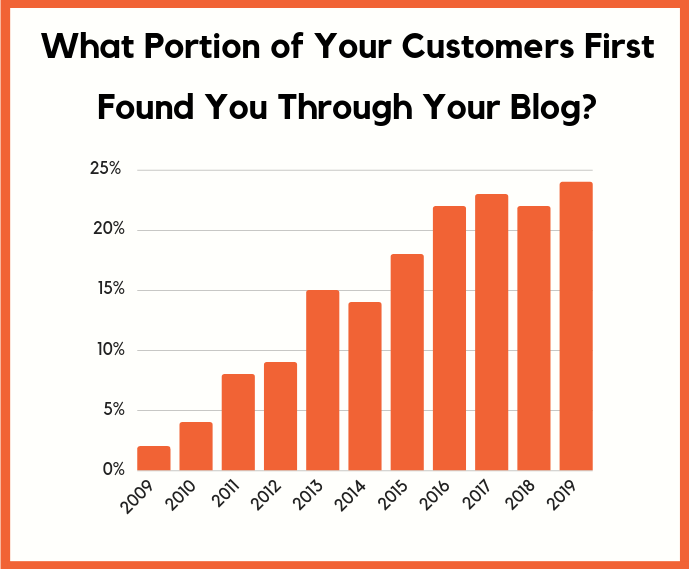
Think of your blog as a funnel.
At the top of the funnel, you want to attract as many people as possible. The more people you attract, the more revenue you’ll eventually end up generating.
As you can see from the graph above, 24% of customers first found out about the company through their blog.
Now, that doesn’t mean they converted into a customer right when they landed on the blog for the first time. More so, they learned about the company first through their blog.
Not only do search engines love blogs, so do people. And the trend is continually rising over time.
When someone reads your blog, it builds trust and causes your conversion rate to increase.
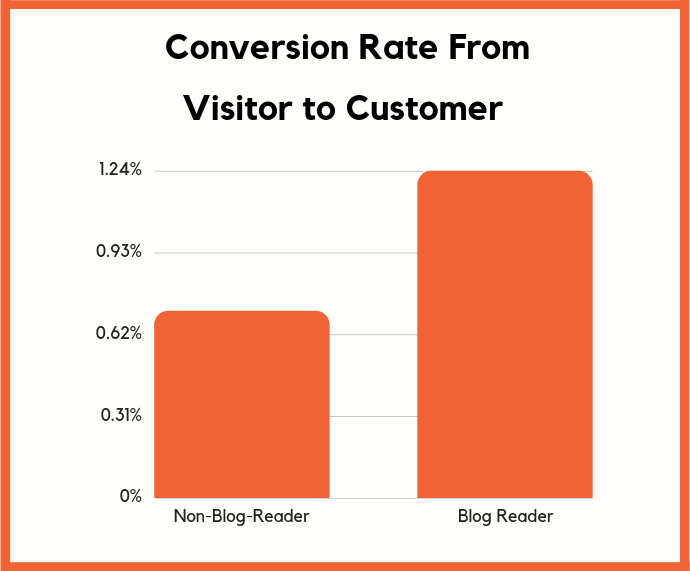
The graph above shows how someone who reads your blog is 74% more likely to convert into a customer compared to someone who hasn’t read your blog.
Advertising is only getting more expensive each year. By blogging more frequently, you can boost your conversion rates.
But don’t expect people to convert right away when they read your blog.
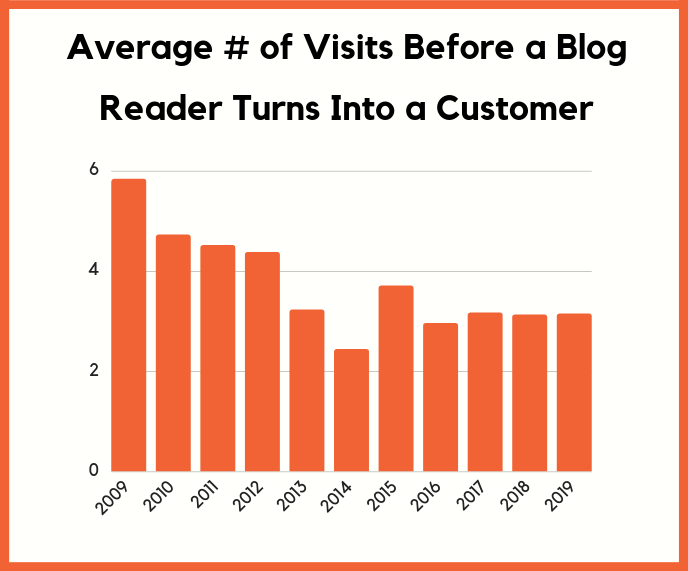
The average number of times someone needs to come back to your blog before they convert is 3.15 times and they tend to convert over a 2-week period of time.
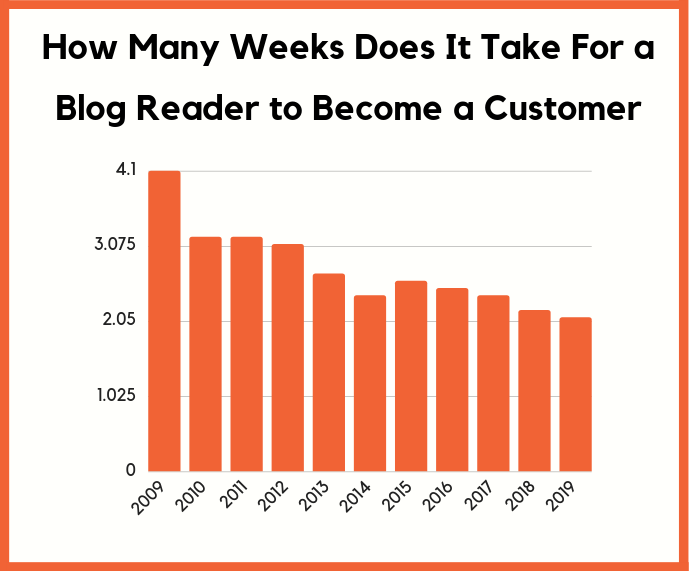
Now, you’ll also find that as you create content people don’t just open up their wallets and give you their money. You need to push them to convert.
The trend we saw is that blogs are leveraging more methods than ever to convert visitors into customers.
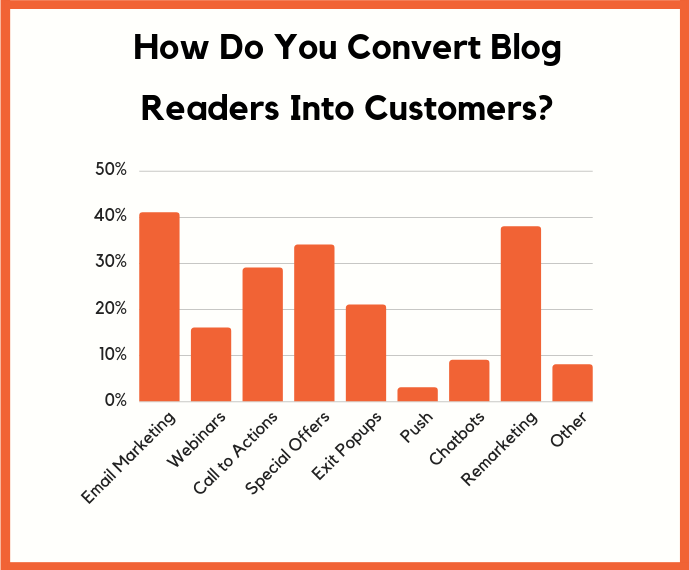
Email marketing is the main method bloggers are using, which isn’t a surprise. But the number 2 method is remarketing.
When I dug into it, these companies on average spend $51,409 a month on paid ads. And each year they saw their ad costs drastically increase. But what’s helped reduce their blended CPA is remarketing all of their blog readers.
In the coming years, remarketing will overtake email as the main way companies are converting readers into customers.
You’ll want to leverage this channel as well as it is much more affordable than search ads.
What countries do you think most blog readers are coming from? You probably are going to guess the United States or other native English speaking countries.
It used to be that way 10 years ago, but things have changed.
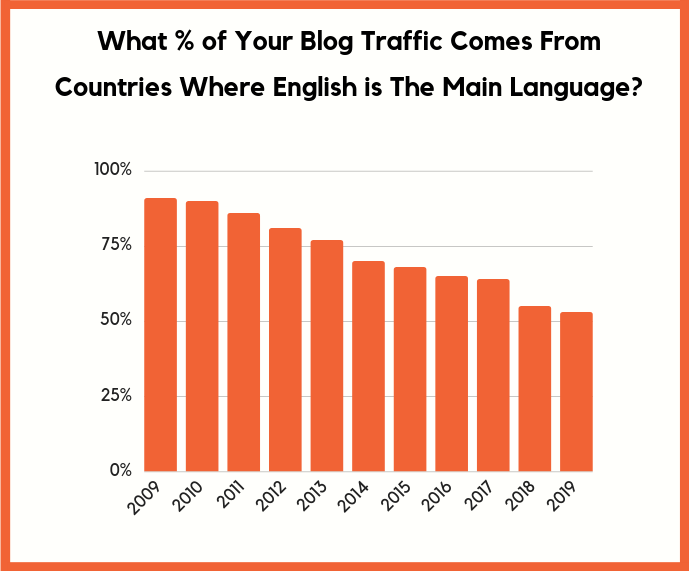
At one point it was 91% but now it has dropped down to 53%. This has also created a trend in which companies are now translating their content to different languages.

It’s taken a while for companies to adopt the concept of globalization with their digital marketing but now it’s catching on fast.
I was able to ride the trend before most people because I got pushed to do so by a Google employee. It was the best marketing advice and it seems to be true for pretty much every blogger out there.
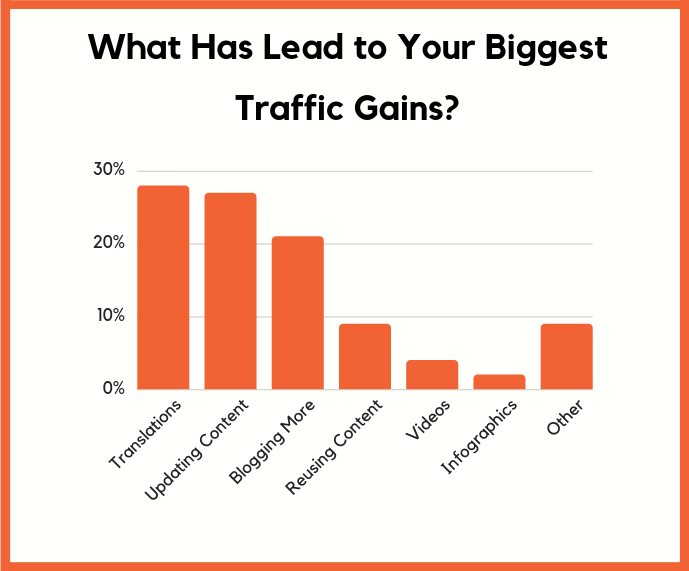
As you can see from the chart above, the biggest traffic gains content marketers are currently getting are from translating their content into multiple languages.
The second biggest gain is coming from updating old content. Content marketing is no longer a game of cranking out hundreds of articles a month. If you want to continually do well, you have to maintain and keep your old content up to date.
When you are building out your content marketing team, focus 50% of their effort on updating old content.
The last biggest trend is WordPress isn’t the only content player these days. If you are going to write a blog post, might as well get the most traffic by placing it everywhere.
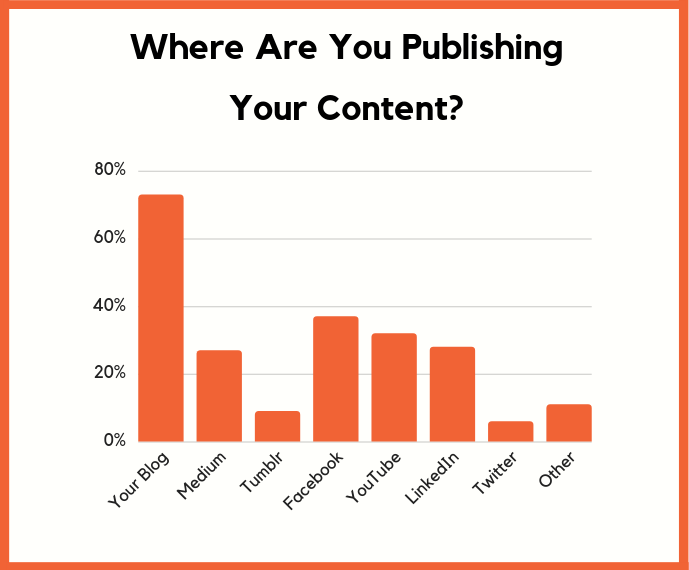
Medium and Tumblr are also great for content. Remember, Google doesn’t penalize for duplicate content. There is nothing wrong with putting content on your blog and then publishing it on Medium and Tumblr a week later.
You can do the same with the social shares… in addition to sharing your content on Facebook, you can publish your whole post a week later on Facebook.
And if you are creating video and audio content you can upload them to Facebook, LinkedIn, YouTube, Instagram and any other platform that will accept it.
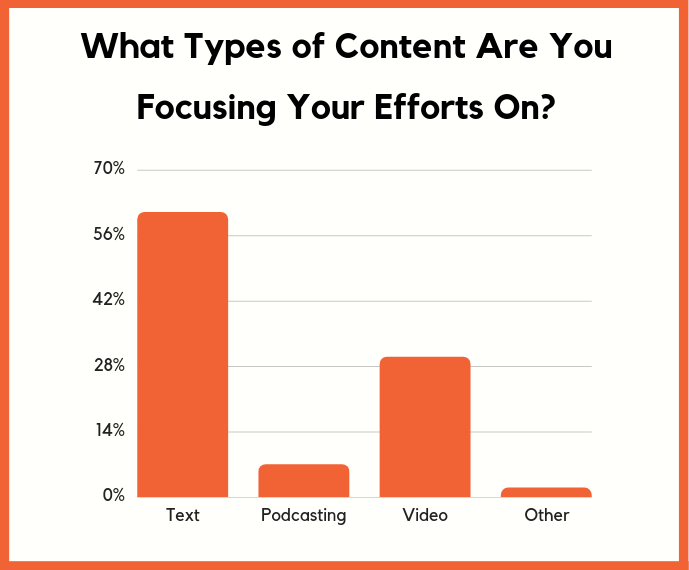
You’ll see huge growth in video and audio content over the next few years.
Facebook, YouTube, and every major platform want their slice of the television market.
Because of that, their algorithms are acting more favorable to content types that keep people on their platform and engaged for hours… hence, you need to expand outside of just text-based content.
It’s also why I’m big on YouTube right now. It diversifies your traffic sources in case you get hit by a Google algorithm change.
If you are going to take one thing from the charts above, you need to focus on translating your content to other languages as it isn’t as competitive.
In addition to that, you need to focus on creating video and audio-based content. Videos have already starting to take off, podcasting isn’t there yet, but it will within the next few years.
I would also tell you to blog, but you probably already have one. 😉
What other content marketing trends have you noticed?
email marketing para windows 8
By telling a story Ellie, a video strategist form StoryMe, starts to explain how to use videos as an inbound marketing tool.